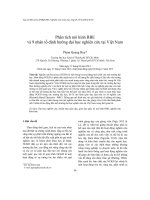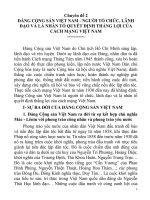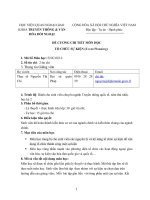Solution to enhance service quaility at akzonobel powder coatings viet nam company
Bạn đang xem bản rút gọn của tài liệu. Xem và tải ngay bản đầy đủ của tài liệu tại đây (574.54 KB, 65 trang )
UNIVERSITY OF ECONOMICS HO CHI MINH CITY
International School of Business
-------------------------
Dang Thi Ngoc Xuan
SOLUTIONS TO ENHANCE SERVICE QUALITY
AT AKZONOBEL POWDER COATINGS VIET NAM COMPANY
ID: 22120083
MASTER OF BUSINESS ADMINISTRATION
SUPERVISOR: PGS. TS. Tran Ha Minh Quan
Ho Chi Minh City – Year 2015
Abstract
The “servitization of business” (Vander Merwe and Rada, 1988) is movement even
in manufacturing industry. So AkzoNobel Powder Coatings who is a leading
manufacturer in Viet Nam powder coatings industry focus on customers, products
and service commitments continuously. Delivering an efficient and effective
customer service is their primary objective. They deliver activities to promote
business through the provision of technical support, problem solving and other
services for customers. They serve a wide and diverse group of manufactures
including architecture, automotive and other products.
Moreover, through previous reports on yearly customer satisfaction survey,
AkzoNobel Powder Coatings recognize that their customers‟ satisfaction and
loyalty are decreasing currently due to low service quality measured through
SERVQUAL (Parasuraman et al., 1985). It is essential to design the improving
customer service plan for AkzoNobel to maintain and develop the business
performance. This lead to the purpose of this thesis:
The first objective is to investigate the real cause of service quality problem
influencing on business performance, focusing on quality dimensions. Particularly,
this study aims to investigate the service quality gap that is defined as the real cause
of difference between customer expectations and perceptions of service through the
Gap model (Bergman & Klefjo, 1994).
1
Importantly, the final objective is to build the improving action plan, especially for
complaint handling to enhance the customer service process at AkzoNobel Powder
Coatings Viet Nam.
To achieve the research objectives, the empirical study and literature study
undertaken. Quality dimensions, service quality gaps and quality measures in
manufacturing company were the three areas that are reviewed in the literature
review study.
AkzoNobel Powder Coatings Viet Nam has a wide service portfolio with different
types of services, which can be classified as product oriented and relationship based.
Through survey, interviews and secondary data analysis, quality measures and gaps
relevant for service quality problems were identified, and the purpose could be
fulfilled.
Keywords: powder coatings, service quality, customer satisfaction, complaint,
solutions
2
Nomenclature
ANPCVN
AkzoNobel Powder Coatings Viet Nam
CMO
Color Matching Optimization
CCS
Customer Complaint Service
CSat
Yearly Customer Satisfaction Survey
CTS
Customer Technical Service
ICT
Information and Communications Technology
KAM
Key Account Manager
KPI
Key Performance Indicator
MS
Managed Services
HR
Human Resource
OTIF
On-Time-In-Full
QA
Quality Assurance
TC
Technical Consulting
SDM
Service Delivery Manager
3
List of Figure and Table
Table 1 Service portfolio at ANPCVN‟s service portfolio
Table 2 Cost and Benefit Comparison between alternative solutions
Table 3 Strategy Evaluation
Table 4 Customer Service Action Plan Template
Table 5 Comparison of sales performance in 2014 and 2015
Table 6 The comparison of sales volume between actual sales and budget
sales in 2015
Table 7 The comparison of complaint volume in 2014 and 2015
Table 8 The overall average of product quality in 2015
Table 9 The overall average of service quality in 2015
Table 10 The Customer‟s evaluation of complaint service quality in 2015
Table 11 List of Interviewees
Table 12 List of quality measures Overview of different measures mentioned by
different researchers
Table 13 Definitions of the five quality dimensions proposed by Parasuraman et
al. (1988)
Figure 1 The cause-and-effect of ANPCVN‟s service quality problem
Figure 2 The technical meeting procedure
Figure 3 The suggested customer complaint handling process
Figure 4 Connection between service quality, customer satisfaction, loyalty, and
repurchase intention inspired by Oh (1999)
Figure 5 Model of service quality gap by Parasuraman et al. (1985)
4
Contents
Abstract
.......................................................................
Nomenclature .................................................................................................................................
1.
Problem Identification ......................................................................................................
1.1 Powder Coatings ..........................................
1.2 AkzoNobel Powder Coating Viet Nam ........
1.3 Problem Justification ....................................
1.4 Causes Justification .....................................
2.
Alternative Solutions ......................................................................................................
2.1 The overall service delivery strategy ..........
2.2 Developing the Account Managers‟ compet
2.3 Cost and Benefit Comparison .....................
3.
Selected Solution ...........................................................................................................
3.1 Justification Solution ...................................
3.2 Action Plan ..................................................
4.
Supporting Information...................................................................................................
4.1 Company Data .............................................
4.2 Customer Satisfaction Survey ......................
4.3 In-depth Interviews .....................................
4.3.1
Custom
4.3.2
Employ
4.4 Literature study ...........................................
4.4.1
Custom
4.4.2
Service
References ....................................................................................................................................
Appendix 1 Items for Measurement of Internal, External Service Quality and Consequence
of Organizational Service Quality in manufacturing Supply Chain. Measurement on fivepoint Likert Scale .........................................................................................................................
Appendix 2 Interpon Customer Satisfaction Survey 2015 ..........................................................
Appendix 3 Definition of quality dimensions..............................................................................
Appendix 4 Customer Complaint Form......................................................................................
5
1. Problem Identification
In this chapter, the background to the research is presented followed by an
introduction of AkzoNobel Powder Coatings Viet Nam with the service portfolio.
Furthermore, the service quality problem that is developed cause-and-effect tree is
also justified.
1.1 Powder Coatings
Powder coating which is a dry finishing process that has become extremely popular
since its introduction in North America over 40 years ago. Representing over 15% of
the total industrial finishing market, powder is used on a wide array of products.
More and more companies specify powder coatings for a high quality, durable
finish, allowing for maximized production, improved efficiencies, and simplified
environmental compliance. Used as functional and decorative finishes, powder
coatings are available in an almost limitless range of colors and textures, and
technological advancements.
Powder coatings are based on polymer resin systems, combined with curatives,
pigments, leveling agents, flow modifiers, and other additives. These ingredients are
melting mixed, cooled, and ground into a uniform powder similar to baking flour. A
process called electrostatic spray deposition is typically used to achieve the
application of the powder coating to a metal substrate. This application method uses
a spray gun, which applies an electrostatic charge to the powder particles, which are
then attracted to the grounded part. After application of the powder coating, the parts
enter a curing oven where, with the addition of heat, the coating chemically reacts to
6
produce long molecular chains, resulting in high cross-link density. These molecular
chains are very resistant to breakdown. Powder coatings can also be applied to nonmetallic substrates such as plastics and medium density fiberboard.
1.2 AkzoNobel Powder Coating Viet Nam
AkzoNobel Powder Coatings is truly global business, with around 4,000 dedicated
employees spread throughout five continents, head office in Sassenheim, The
Netherlands. They have around 30 manufacturing plants in 20 countries and have
sales offices and representatives in more than 40 countries around the world. They
serve the market with two global brands are Interpon and Resistcoat to supply to 9
key market sectors – ACE, Appliance, Architectural, Automotive, Functional,
Furniture, General industry, IT and Trade coaters. They coat everything from
window framing, building facades and curtain walls to furniture, office equipment,
radiators, and computers, cars, plastic and even wood.
Their core principles are safety, integrity and sustainability. These work in harmony
with the values – Customer focused, Deliver on commitments, Passion for
excellence and Winning together.
In Viet Nam, AkzoNobel Powder Coatings has achieved several significant
milestones:
-
2001: Join Venture between AkzoNobel Coatings International BV (50
percentages) and Chang Cheng Securities HongKong (50 percentages)
-
2002: Start operation at factory in Dong Nai Province, Viet Nam
7
-
2010: Chang Cheng acquisition, 100 percentages owned by AkzoNobel
Powder Coatings
Name of Company: AkzoNobel Powder Coatings (Viet Nam) Limited Company
Factory: Road 2, Nhon Trach 1 Industrial Park, Dong Nai Province, Viet Nam
Office: Flemington Tower, 182 Le Dai Hanh Street, District 11, Ho Chi Minh City
Telephone: + 84 61 3650730
Fax: + 84 61 3650740
Registered investment capital: $4.0 millions
Legal capital: $2.5 millions
2
Total leased land: 10,000 m , last for 46 years at the fee of USD $8.2
thousands/year, currently occupied 100 percentages.
Their product is leading in the market with many advantages, including:
-
Environmentally friendly with no Volatile Organic Compounds
-
Contains no toxic heavy metals such as lead or chromium
-
Single Coating, therefore uses less energy during application
-
Overspray can be reclaimed and reprocessed resulting in almost ZERO
waste
-
Produces less hazardous waste during production and low carbon footprint
-
1 Coatings company to achieve a SMaRT certification
st
AkzoNobel Powder Coatings Viet Nam (ANPCVN) who is today leading supplier
powder coatings for more than 300 buying customers in Viet Nam, is one of the
many companies that have been going through the service transition. They offer
8
different services including pre-sales, during-sales and after-sales services, such as
color matching, line trial, and benchmarking as well as complaint services for their
customers.
A brief presentation of the seven different categories in the service portfolio can be
seen in Table 1.
Table 1 Service portfolio at ANPCVN’s service portfolio
Color Matching Optimization
(CMO)
On-time-in-full (OTIF)
Technical Consulting (TS)
Customer Technical Services
(CTS)
Complaint Services (CS)
Managed Services (MS)
1.3 Problem Justification
The ANPCVN‟s sales performance in 2015 decrease 8 percentages compared to
previous year which board of management pay attention to while the market growth is
evaluated 13 percentages. Meanwhile, the number of complaint increase rapidly from
87 to 148 issues (the justified problem is less than). Interviewing the Sales Manager
and Key Account Managers, they concern about the product quality, customers‟
feedback and Account Managers Team‟s competency. Personally, Sales Manager
believes to evaluate the product quality of ANPCVN is very good and
9
competitive in the market. He judges that the problem comes from the low
customers‟ satisfaction.
A variety of studies emphasize customer satisfaction as a necessary condition for
customer retention and loyalty (Fornell 1992, Bolton 1998, Morgan and Strati 2000),
that can help secure future revenues (Rust and Zahorik1993, Scheuing, 1995;
Reichheld, 1996; Helgesen, 2006,). Through delivering a high level of satisfaction,
firms can decrease the costs of future transactions (Reichheld and Sasser 1990,
Shneider 2000), decrease price sensitivity (Anderson 1996, Shneider 2000) and
complaint behavior (Fornell 1992, Bolton 1998, Barlow and Moller 1996). The
literature also presents multiple positive effects of customer satisfaction on
improvement of brand image (Lawson and Glowa 2000), company reputation and
positive recommendations (Anderson and Sullivan 1993, Zairi 2000, Anderson,
Fornell and Mazvancheryl 2004), employee motivation (Muffatto and Panizzolo,
1995, Naumann and Hoisington 2001) and identification of improvement areas
(Pasquier and Fastnacht, 2001). Otherwise, customer satisfaction is an erratic
element; one certain product or service may satisfy a customer may not satisfy
another customer. Therefore, in order to increase the customer‟s satisfaction the
maximum, the factors which may influence customer‟s satisfaction must be
understood properly. The customers need to be satisfied with the products or
services that they have experienced first. Therefore, in order to make customers
satisfied and accordingly to be loyal, the service or product quality needs to be
improved.
10
The customer satisfaction survey which is according to items for Measurement of
Internal, External Service Quality and Consequence of Organizational Service
Quality in manufacturing Supply Chain shown in Appendix 1, valuate both
expectation and performance using a seven point Likert scale ranging from 1 to 5.
The overall weighted average of customer satisfaction in 2015 is 3.91 that is less
than previous year, 4.02 shown in Chapter 4.
Particularly, customers evaluate the product quality is higher and consistent with
new technical specifications and they accept the high price compared with other
suppliers. However, they require the good guideline application and prompt action
in order to avoid and solve the production problem issues. Meanwhile, ANPCVN
develop the new procedure, facilities to control and improve the quality of new high
technology products. In general, the customers are satisfied with product quality
with high evaluated number 4.04 in Table 7.
Otherwise, due to the communication and transferred technique between Account
Managers and customers is not enough while customers‟ production conditions are
different each other, the production problems happen in the customers‟ production
line increasingly. However, when receive the complaints from customers; the
Account Managers give the feedback and solution in longer time than commitment
as well as customers‟ expectation. These are the important causes for the
decreasing satisfaction of customers show the low responsiveness dimension.
Quality and customer satisfaction is often presented only as a result of each other.
Most of the studies of consumer satisfaction highlight the unavoidable relationship
11
between customer satisfaction and quality. Sureshchander, Rajendran, and
Anantharaman (2002) argued that an increase in one is likely to increase the other,
therefore service quality and customer satisfaction are closely related. Others
(Ranaweera and Neely 2003) also report that service quality is often positioned as an
antecedent of customer satisfaction.
Another approach that explains creation and connection between customer satisfaction
and quality is the PROSAT model (Schneider 2000). It is a multidimensional model that
suggests that customer satisfaction can be seen as twofold: as a real value delivered by
the firm and subjective customer‟ expectations. This model is theoretically rooted in
the Parasuraman‟s Model of Service Quality (1985). According to the PROSAT these
are the following dimensions that influence development of Customer Satisfaction: 1)
Technical product quality – conformation to specification requirements, safety,
sustainability, environmental safety. 2) Quality of reputation – customer‟s perception
about company and product/service that is based on his/her subjective benchmarking of
competing companies, their competencies, brands and reputation. 3) Price perception –
list price, discounts, sales promotions, perceived value. 4) Quality of interpersonal
relationship – communication styles, empathy, complaints handling. 5) Service quality
– sales personnel competency, immediacy of response, safety, tangible components of
service (sales personnel appearance, atmospherics, equipment and promotional
materials). Through the in-depth interview with employees and customers as well as the
customer satisfaction survey, the customer satisfaction of service quality is lower
12
than previous year. It is essential to improve service quality dimension in PROSAT
as the potential central problem.
The PROSAT Model presents the concept of customer satisfaction creation that is
the result of a mutual relationship between organization and buyer. It is possible to
achieve this state only when communication between both parties occurs. Firms
should know (through market intelligence) what the customer‟s needs and
expectations are in order to deliver expected quality. Customers should be able to
anticipate what level of quality the company is able to deliver at the accepted price,
and therefore set the level of expectations. Quality is currently one of the major
factors satisfying the customer.
Service quality is considered as a critical dimension of competitiveness (Lewis,
1989). Providing excellent service quality and high customer satisfaction is the
important issue and challenge facing the contemporary service industry (Hung et al.,
2003). Service Quality is an important subject in both public and private sectors, in
business and service industries (Zahari et al., 2008). It is the extent to which a
service meets or exceeds customer needs and expectations (Lewise and Mitchell,
1990; Dotchin and Oakland, 1994a; Asubonteng et al., 1996: Wisniewiski and
Donnelly, 1996; Seilier, 2004; Zahari et al., 2008). During the past two decades,
service quality has become a major area of attention to practitioners, managers and
researchers because of its strong impact on business performance, lower costs, return
of investment, customer satisfaction, customer loyalty and gaining higher profit
(Leonard and Sasser, 1982; Cronin and Taylor. 1992; Gammie, 1992; Hallowell,
13
1996;Chang and Chen, 1998; Gummesson, 1998; Lasser et al., 2000; Newman, 2001;
Sureshchander et al., 2002; Seth and Deshmukh, 2005).
Based on the literature of model service quality five gaps (Parasuraman et al., 1985),
two in-depth interviews were conducted in order to gather the information from the
customers and employees about their opinion which related to the service. Firstly indepth interview questionnaire as in Appendix 2 is designed to conduct to ten buying
customers. The customers who experienced the problems concern about complaint
solutions mainly. They evaluate the solving time is longer than 48 hours while they
need to solve problem immediately to limit the rising cost. Some of them show
expectation about the Account Managers with higher capabilities to response and
react in time.
Focusing on the customers‟ concerns, the in-depth interview is conducted to ten
Account Managers. The conversations between researcher and Account Managers
try to talk about the experience and perception of serving customers, especially for
customers‟ complaints. Account Managers agreed the problem solving time for
customers longer than specifications even their expectation. Investigating further
about the reasons, it found that Account Managers find complex procedure to work
with internal departments to analyze and solve the problem for customers. They
have to try to contact to departments such as technical, QC and Logistics to collect
data, information to give the solution for customers. Besides, they also agreed about
the technical knowledge as well as trouble shooting capabilities need to be improved
priority so that they can serve customers well for customers‟ higher expectation.
14
Another interviewing is conducted to the Quality Assurance Manager to investigate
the complaint procedure to support the Account Managers react the customers‟
complaints. She also suggest about the new procedure to internal departments
support analyze and recommend for customers solve problems.
As a result, the problem service quality is the problem need to be analyzed the
causes and solved it completely. By enhancing perceived service quality to
consumers, the company is able to increase the perceived costs of switching from
one service firm to another (Meng, Elliott 2003). Firms make significant
investments in quality programs with the hope of generating huge increases in
profitability (Douglas and Erwin 2000). Return on investments in the processes of
delivering high quality (implementation of quality management system) can be seen
through increased sales (Bank 1996).The more the quality improves, the faster the
sales increase, because satisfied customers buy more (Morgan at al. 2000).
1.4 Causes Justification
From the interviews with the customers, it was clear that the Account Managers are
prompt in action and consistent in delivering high service are the key concerns of the
customers. These are the contextual interpretation of reliability which is identified as a
service quality dimension by Parasuraman (1985; 1988). Why prompt action precision
is so important for service quality can also be understood from a solution quality
perspective. As discussed in the theoretical background Johansson and Witell (2013)
defined reliability for solutions as “the extent to which the solution can be
15
relied on to provide what is needed at the right time”. In this company case, the
reliability present through the low sales personnel competence.
Johansson and Witell (2013) identified tangibles as a quality dimension for solutions.
However, in service measurement, tangibles are not relevant as a quality dimension.
The quality dimension responsiveness was defined as “willingness to help customers
and provide prompt service” by Parasuraman et al. (1985; 1988). Quick action and
response are as something that could make the customer more satisfied. The response
time is mentioned in the interview with the customer as Account Managers
“willingness to help and solve problems” which was the attribute that created most
satisfaction. This present through the delaying response and action in case customers
have problem. Responsiveness is certainly important for the customers and as
Carman (1990) argue, when a quality dimension is very important it might have to be
split into sub dimensions. Therefore it is more relevant to address this by two standalone dimensions: Approachability, which is a dimension by Johansson and Witell
(2013) for the importance of a fast response and how easily and convenient the
customer can contact the supplying company, and “willingness to serve” by Hedvall
and Paltschik (1989).
Johansson & Witell (2013) identified flexibility as a quality dimension which concerns
the ability to meet customers‟ changing needs but also the extent to which the solution
offering can be adjusted to fit the customer‟s initial needs. Flexibility can therefore be
seen as a quality dimension grasping these customer requirements
16
for service. For ANPCVN, this dimension is the immediate actions and flexible
solution of account manager and CTS to solve customer‟s problem priority. From
the customer interview it was also highlighted that it is important to be listened to
and not questioned when there is a problem. It is important for the customers to feel
that Account Managers understand their situation, needs and feelings. These more
soft values are similar to the quality dimension empathy that was identified by
Parasuraman et al. (1985; 1988). That empathy emerged as important for technical
consulting for product related services. The Account Managers and the customer
have frequent contact and according Chowdary and Prakash (2007) and Lee and
Kim (2013) empathy is an important dimension in those scenarios. It might also be
explained due to the stress the customer feel in the interaction since they usually
contacts the Account Managers when they have a problem.
While assurance in previous research mainly concerns personal attributes and the
service provider's ability to inspire trust and confidence in the customer
(Parasuraman et al., 1988), the assurance discussed by the customer in this case
study is more concerned with the width of APCVN‟s offering, capability to deliver
and overall approach to solve the customer‟s problems. Therefore assurance could
be seen as parts of the quality dimensions willingness to serve and reliability and not
as a stand-alone dimension.
Consistency is a solution quality dimension identified by Johansson and Witell
(2013). As previously discussed consistency is concerned with how knowledgeable
17
employees are of the entire solution so that no promises are made to the customer
that cannot be fulfilled (Johansson & Witell, 2013). On the other hand Johansson
and Witell (2013) also mean that consistency is concerned with the ability to answer
customer questions regarding the entire solution. For service this would mainly
concern the competence and knowledge of specifications. However the Account
Managers are new entry mostly with less experience and knowledge. This
inconsistency was visible to the customer and caused complaints from the customer.
A study of executives in 50 firms identified the process for handling customer
complaints as a key driver of customer satisfaction (Mohr-Jackson 1998). Through
customer survey and employees interview, ANPCVN‟s account managers and CTS
do not have enough confidence and prompt feedback for customer‟s concern. They
often feedback for later feedback by related other departments.
ANPCVN is leading manufacturer in market, customer evaluate the high service
quality, good reputation and technology. The service quality is little lower than
previous year that is very important to company‟s reputation, customer loyalty. It
will increase the cost for developing new customers as well as maintaining buying
customers. Importantly, ANPCVN‟s value focus on the commitment related to
quality and service which is their competitive factor in the market. Many
competitors also definite the service quality is their competitive strategy. As a result,
in case ANPCVN delays in solving the service quality problem, they will lose
position on competitive market.
18
ANPCVN‟s Account Managers attract customers by the high service quality
specifications as well as commitments, but they deliver the lower service quality due to
low reliability and responsiveness. It is clear to conclude the real cause is that ANPCN
is failing to implement service quality specifications in the company. In the other word,
this service performance gap is the cause of low service quality problem.
Figure 1 The cause-and-effect of ANPCVN’s service quality problem
Low sales personnel
competency
Lower sales
performance
Delaying of response
Delaying of action
Inflexibility
Low staff cooperation
Inefficiency extern
communication
Lack of promoting
materials
Consequently, ANPCVN need to plan the solutions that will enhance the service
quality, especially focus on reliability and responsiveness dimensions for technical
and complaint services in order to improve customer satisfaction as well as
differentiate them from another.
19
2. Alternative Solutions
In this chapter, three solutions are developed for the most important cause of service
quality problem which are justified by data from internal and external interviews.
The alternative solutions are proposed to solve two important causes which are
determined in previous section. The solutions are designed based on discussing with
board of managers, especially Sales Manager, QA Manager and HR Manager. It
also combine the harmonize strategy related to procedure, employees development
and business targets for South Asia Countries.
2.1 The overall service delivery strategy
Solution: Define and create the overall service delivery process and measurement
framework including new complaint service procedure that determine service
efficacy
Target: Maintain a well-publicized, accessible, transparent and simple-to-use
system of dealing with complaints
KPIs:
-
Treat all customers with courtesy and respect.
-
Ensure that all complaints are treated promptly, fairly and impartially.
-
Ensure that customers are aware of how to make complaints under the
Department‟s complaints procedures.
-
Provide an opportunity for customers to make a comment or complaints at all
points of service delivery.
20
-
Promote the availability of the comments and complaints system
through SharePoint network
-
Ensure that complaints are dealt within 2 working days of receipt.
-
Review customer feedback from the operation of the comments and
complaints system to improve service delivery.
-
Meeting Customer Needs And Priorities
-
Providing Services Cost Effectively
-
Controlling Service Delivery
2.2 Developing the Account Managers’ competency program
Solution: Provide and improve the relationship and communication with
customer by developing Account Managers‟ competency
Target: Take a proactive approach in providing information that is clear, timely and
accurate, is available at all points of contact, and meets the requirements of
customers.
KPIs:
-
Ensure that the offered services are fully availed of and follows the highest
standard by the capable staff
-
Create the environment for sales and representatives exchange and enrich
their knowledge and experience during sales activities, problem solving
and technical supports.
-
Ensure that all information provided to customers by staff of the Department
is comprehensive and accurate.
21
-
Ensure that customer queries are responded to in a timely manner.
-
Ensure that offered services are of the highest standard.
2.3 Cost and Benefit Comparison
Due to the time constraint as well as save the resources, it is essential to justify the
best solution which is the most effective and efficient to solve the service quality of
the ANPCVN. Furthermore, the detailed counter action plan is also presented in next
chapter.
Table 2 Cost and Benefit Comparison between alternative solutions
Solution
The overall service
delivery strategy
Developing the
Account Managers‟
competency
program
22









